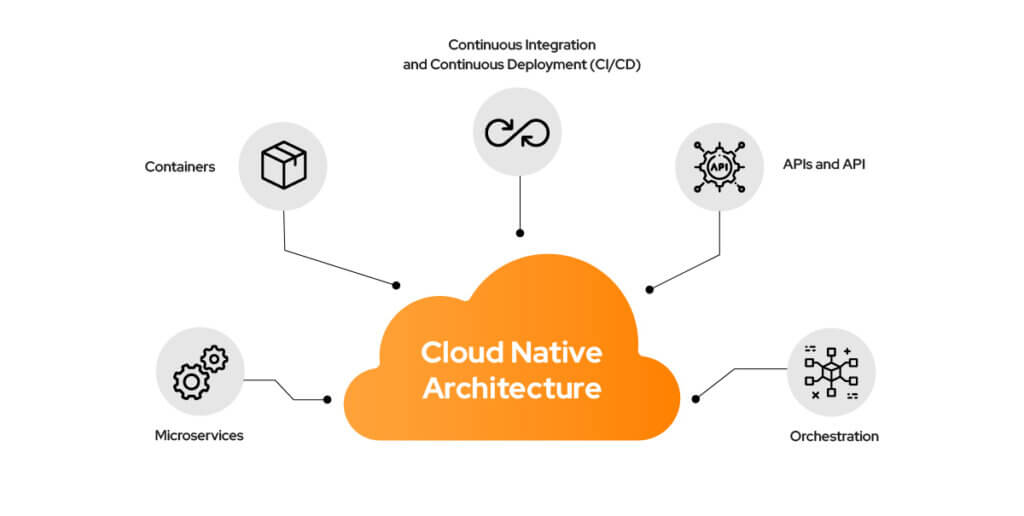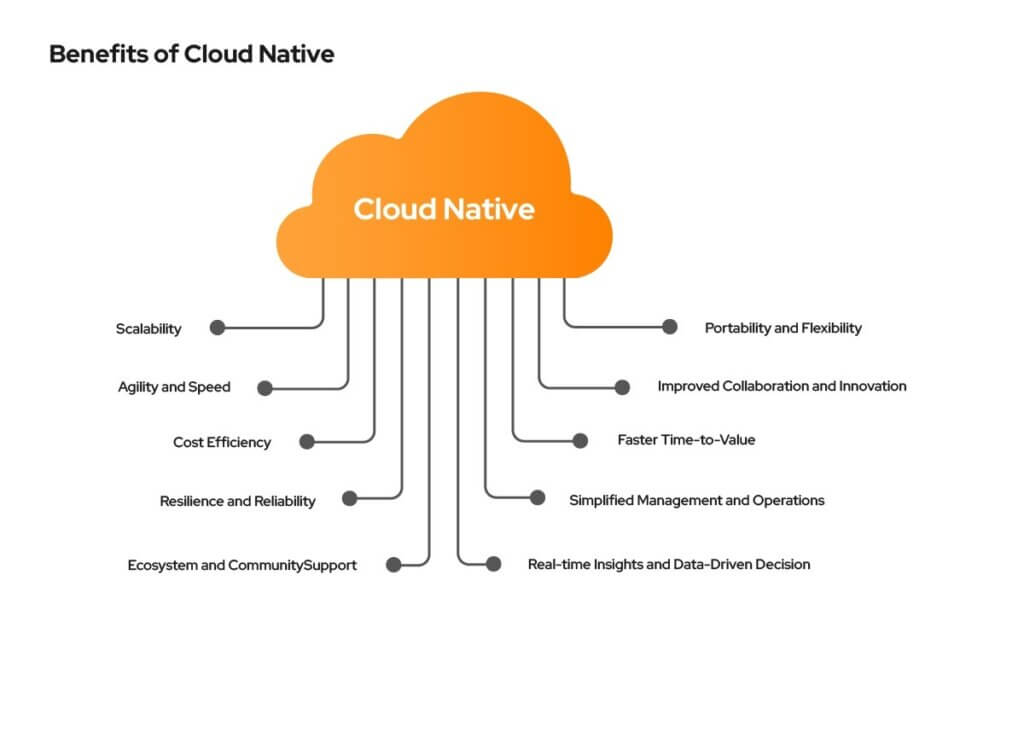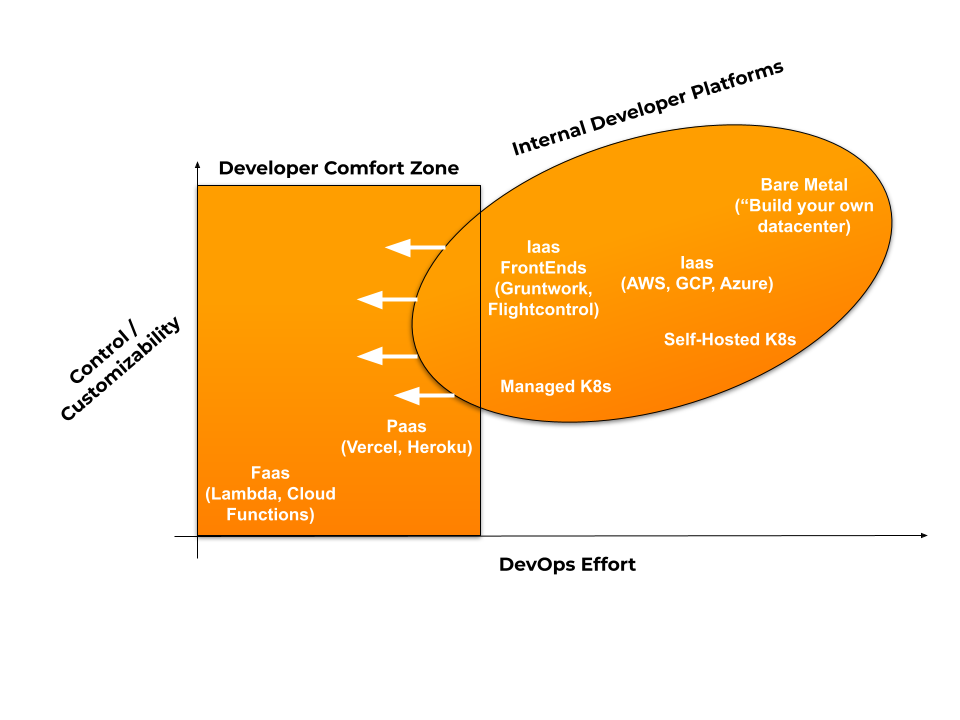
Why Choose Cloud Native and the Benefits it Provides
Today let us dive into the essentials of cloud native technology and discover the key components, advantages, and platform selection strategies in our exhaustive guide. Discover how and why cloud native applications empower organizations to build a solid foundation for growth and adaptability in a dynamic digital environment.
21 min read
In this Article:
- Explore the evolution of cloud computing and the rise of cloud native technology.
- Discover the key components of cloud native architecture, including microservices, containers, and CI/CD pipelines.
- Uncover the numerous benefits of adopting a cloud native approach, such as scalability, agility, and cost efficiency.
- Learn how to choose the right cloud native platform for your organization’s unique needs and objectives.
- Delve into the concept of self-hosted Kubernetes in the cloud, its various approaches, and the benefits it offers.
Introduction
Cloud native technology has rapidly become the cornerstone of modern software development, transforming the way applications are built, deployed, and maintained, a game-changer in the software development world, that has reshaped how applications are built, deployed, and managed. This cutting-edge approach leverages the full potential of cloud computing, offering a multitude of benefits that traditional software development methods simply cannot provide. Today, let us delve deep into the essence of this solution, the key components of its architecture, and the compelling reasons why businesses are making the switch. From improved scalability and agility to cost efficiency, cloud native applications are paving the way for a new era of software development. So, whether you’re a seasoned IT professional or a curious entrepreneur, join us as we explore its intricacies and uncover its potential to revolutionize your business.
The Evolution of Cloud Computing
The genesis of cloud computing can be traced back to the early 2000s when companies like Amazon and Salesforce pioneered the concept of delivering computing resources as a service. This revolutionary approach allowed businesses to offload their IT infrastructure and focus on their core competencies. Over time, as more organizations recognized the benefits of outsourcing their computing needs, cloud computing rapidly gained traction.
However, traditional cloud computing primarily centered on providing virtualized infrastructure for running applications. This approach, while beneficial, fell short in addressing the needs of modern, distributed, and scalable systems that characterize today’s digital landscape. Thus, cloud native technology emerged to bridge this gap and redefine the way applications are designed, built, and operated.
Cloud native represents a paradigm shift, enabling organizations to fully harness the power of the cloud by adopting a more holistic approach. This innovative methodology integrates elements such as microservices, containers, APIs, and continuous integration and deployment (CI/CD) pipelines to create agile, resilient, and scalable applications. The evolution of cloud computing has come a long way, and with the advent of cloud native technology, it is poised to propel businesses into a new era of software development, marked by unparalleled flexibility, adaptability, and efficiency.
Key Components of Cloud Native Architecture

The cloud native approach is built upon a set of foundational components that work in tandem to create a robust, flexible, and scalable architecture. These key elements are designed to address the unique challenges and requirements of modern software development. Let’s delve into each of these components and understand their significance in the cloud native ecosystem.
Microservices architecture: A departure from the monolithic application design, cloud native applications embrace the microservices. This approach involves breaking down applications into small, loosely-coupled services that can be independently developed, deployed, and scaled. By focusing on a single functionality, each microservice is easier to maintain and update, fostering rapid development and adaptability to changing requirements. Additionally, this modular structure facilitates better collaboration among development teams, ultimately improving productivity.
Containers: At the heart of cloud native applications lies containerization, a technology that packages software and its dependencies into lightweight, portable units. Containers enable consistent deployment across various environments, from development to production, by encapsulating applications in isolated, resource-controlled environments. This consistency not only improves efficiency but also simplifies the development and operations (DevOps) process.
Continuous Integration and Continuous Deployment (CI/CD): Cloud native applications employ CI/CD pipelines to streamline development and accelerate the delivery of new features or updates. CI/CD is an automated workflow that seamlessly integrates, tests, and deploys code changes, ensuring rapid time-to-market and fostering a culture of continuous innovation. This approach reduces the risk of errors and enables teams to respond swiftly to customer feedback or market changes.
APIs and API Management: In a cloud native architecture, microservices communicate through Application Programming Interfaces (APIs). These APIs serve as the glue that connects individual services, enabling interoperability and modularity. Robust API management is crucial for ensuring secure, efficient, and reliable communication between services. This encompasses practices such as API versioning, access control, rate limiting, and monitoring.
Orchestration: The management of multiple microservices and containers necessitates the use of sophisticated orchestration tools that automate deployment, scaling, and management tasks for complex applications. Kubernetes is a prime example of an orchestration platform, providing a powerful and flexible solution for managing containerized applications at scale.
By leveraging these essential components, cloud native architecture unlocks a new realm of possibilities in software development, empowering organizations to build, deploy, and operate applications with unparalleled agility, resilience, and scalability.
Benefits of Cloud Native

The cloud native approach to software development brings forth a host of benefits that can profoundly impact businesses and their ability to adapt, innovate, and thrive in today’s competitive landscape. Let’s explore these advantages in depth and understand why organizations are increasingly adopting cloud native technology.
Scalability: One of the most compelling advantages of cloud native applications is their ability to scale seamlessly to meet increasing demands. Built with a microservices architecture, these applications can easily scale up or down, ensuring optimal resource utilization and performance. Individual components can be scaled independently, providing flexibility and adaptability for evolving business needs. This scalability not only caters to growing user bases or seasonal fluctuations but also enables businesses to be agile in their response to market changes.
Agility and Speed: Cloud native applications are designed to facilitate rapid development and deployment of new features or updates. By breaking applications down into smaller, loosely-coupled microservices, development teams can work independently and in parallel, accelerating time-to-market. Moreover, the use of CI/CD pipelines streamlines the integration, testing, and deployment of code changes, reducing bottlenecks and fostering innovation. This agility empowers businesses to quickly react to changing market conditions, customer expectations, and competitive pressures.
Cost Efficiency: Adopting a cloud native approach can lead to significant cost savings for businesses. By leveraging the pay-as-you-go model of cloud computing, organizations can optimize resource consumption and reduce operational costs. Auto-scaling capabilities of cloud native applications ensure that resources are allocated efficiently, eliminating the need for overprovisioning. Additionally, the ability to iterate quickly and reduce time-to-market for new features translates to increased cost savings and revenue opportunities. Streamlined processes, like the use of containers and CI/CD pipelines, also contribute to operational efficiencies and cost reduction.
Resilience and Reliability: A key tenet of cloud native applications is designing them to be distributed across multiple nodes, the risk of single points of failure is mitigated, resulting in greater system reliability. Built-in redundancy, coupled with automated recovery mechanisms, ensures minimal downtime and uninterrupted service even in the face of hardware failures. This resilience is crucial for businesses that rely on their applications for critical operations or revenue generation.
Ecosystem and Community Support: The thriving cloud native ecosystem offers a wealth of resources, tools, and frameworks to support the development and operation of cloud native applications. Industry leaders and open-source communities actively contribute to the advancement of cloud native technologies, ensuring continuous innovation and improvement. This support extends beyond technical resources and includes a vast network of professionals and experts who can provide guidance, share best practices, and help businesses successfully navigate their cloud native journey.
Portability and Flexibility: The use of containers and standardized APIs in cloud native applications ensures that they can be easily moved between different environments, such as on-premises data centers or various cloud providers. This portability and flexibility enable businesses to avoid vendor lock-in and choose the best environment for their applications based on cost, performance, or other specific requirements. Furthermore, the ability to migrate applications or individual microservices easily can contribute to improved disaster recovery and business continuity strategies.
Improved Collaboration and Innovation: Cloud native applications promote a culture of collaboration and innovation by fostering a DevOps mindset, which emphasizes close cooperation between development and operations teams. This shift towards a more collaborative approach not only streamlines the development lifecycle but also encourages a greater exchange of ideas and knowledge across the organization. By breaking down traditional silos and creating an environment that supports continuous learning and improvement, businesses can cultivate a culture of innovation and drive sustained growth.
Faster Time-to-Value: As the pace of digital transformation accelerates, businesses must be able to deliver value to their customers as quickly as possible. Cloud native applications, with their agile development practices, CI/CD pipelines, and modular architecture, enable organizations to bring new features and products to market faster than ever before. This faster time-to-value can provide a crucial competitive edge, allowing businesses to stay ahead of evolving customer needs and market trends.
Simplified Management and Operations: Cloud native applications benefit from simplified management and operations, thanks to the use of containerization and orchestration tools. Containerization provides a consistent environment for applications across different stages of the development lifecycle, while orchestration platforms, such as Kubernetes, automate the deployment, scaling, and management of containerized applications. This simplification not only reduces the complexity of managing modern software applications but also frees up valuable time and resources for development teams to focus on innovation and delivering value to customers.
Real-time Insights and Data-Driven Decision Making: Cloud native applications are designed to leverage the vast amounts of data generated by modern digital systems. By incorporating real-time analytics, monitoring, and observability tools into the application stack, businesses can gain valuable insights into application performance, user behavior, and other key metrics. These data-driven insights can inform decision-making, optimize resource allocation, and enable businesses to proactively address issues before they escalate, ultimately leading to better customer experiences and improved operational efficiency.
Choosing the Right Cloud Native Platform

The rise of Cloud Native technologies and container orchestration platforms like Kubernetes has led to an increased demand for solutions that can help organizations develop, deploy, and manage software applications more efficiently. Choosing the right Kubernetes-based platform is critical for organizations to fully harness the benefits of this technology and address their unique business objectives and technical requirements. The three most popular approaches are Managed Kubernetes Services, Self-hosted in Cloud and On-Premises Kubernetes Solutions.
Managed Kubernetes Services
Managed Kubernetes Services are provided and maintained by cloud providers, such as Amazon Elastic Kubernetes Service (EKS), Google Kubernetes Engine (GKE), and Microsoft Azure Kubernetes Service (AKS). These platforms offer several advantages, including:
Ease of deployment, scaling, and management: Managed Kubernetes Services typically simplify the setup and maintenance process, allowing organizations to focus on their core business operations.
Automatic updates and maintenance: Cloud providers take care of updates and maintenance, ensuring that the platform remains up-to-date and secure.
Integrated monitoring, logging, and security tools: Managed Kubernetes Services often include built-in tools for monitoring, logging, and securing applications and infrastructure.
Pay-as-you-go pricing models and cost optimization features: Managed Kubernetes Services usually follow a pay-as-you-go pricing model, allowing organizations to optimize costs based on their actual usage.
Self-hosted Kubernetes in Cloud
Running self-hosted Kubernetes in the cloud involves managing a Kubernetes cluster on a cloud infrastructure provider such as Amazon Web Services (AWS), Google Cloud Platform (GCP), or Microsoft Azure. This approach combines the benefits of self-managed Kubernetes and cloud computing, allowing users to have full control over their Kubernetes environment while leveraging the cloud’s advantages.
Several approaches can be used to achieve self-hosted Kubernetes in the cloud:
Provisioning virtual machines (VMs) on a cloud provider and installing Kubernetes on them: This method involves creating VMs on a cloud provider and manually installing and configuring Kubernetes. It offers full control over the Kubernetes environment, but requires more effort and expertise for setup and maintenance.
Using a Kubernetes distribution with cloud provider integration: Some Kubernetes distributions, such as Rancher, offer cloud provider integration, allowing users to easily provision Kubernetes clusters on a cloud provider. This approach provides a more streamlined experience, as the Kubernetes cluster is automatically integrated with the cloud provider’s infrastructure.
Using a managed Kubernetes service with a self-managed control plane: Some cloud providers, like AWS and GCP, offer managed Kubernetes services that enable users to have control over the Kubernetes control plane while delegating the management of worker nodes to the cloud provider. This approach strikes a balance between control and convenience, as users can focus on managing the Kubernetes control plane while the cloud provider takes care of worker nodes.
Self-hosted Kubernetes in the cloud brings several benefits, including scalability, reliability, and cost-effectiveness. With the ability to scale up or down based on demand, users can ensure their Kubernetes environment is always running smoothly. Additionally, leveraging the cloud provider’s infrastructure allows users to benefit from high availability and fault tolerance, while also reducing operational costs.
For organizations looking to harness the advantages of Kubernetes and cloud computing while maintaining full control over their Kubernetes environment, self-hosted Kubernetes in the cloud can be a powerful solution.
On-Premises Kubernetes Solutions
On-Premises Kubernetes Solutions are designed for deployment within an organization’s data center or private cloud. Examples of these platforms include Red Hat OpenShift, OKD, VMware Tanzu, and Rancher. Key advantages of On-Premises Kubernetes Solutions include:
Greater control over infrastructure and customization options: On-Premises Solutions allow organizations to have more control over their infrastructure, enabling them to tailor the platform to their specific needs.
Integration with existing infrastructure and tooling: On-Premises Solutions can seamlessly integrate with an organization’s existing infrastructure, services, and tools.
Potential for lower latency and data sovereignty compliance: On-Premises Solutions may provide better performance and support for data sovereignty and compliance requirements, particularly for organizations with strict regulatory constraints.
On-premises licensing and support costs: On-Premises Solutions often involve upfront licensing and support costs, as well as ongoing infrastructure expenses.
Comparison of Managed and On-Premises Kubernetes
When comparing Managed Kubernetes Services, Self-hosted Kubernetes in the cloud, and On-Premises Kubernetes Solutions, these three approaches each present their unique advantages and trade-offs, and selecting the right one depends on an organization’s specific needs, resources, and strategic objectives.
Managed Kubernetes Services such as Amazon EKS, Google GKE, or Azure AKS, essentially provide Kubernetes as a service. They offer a higher level of abstraction from the underlying infrastructure, which results in easier deployment and management of the Kubernetes environment. These services handle the operational complexities, leaving developers more time to focus on application development. However, they may not offer the same level of control and customization as other options, and may not be the best fit for organizations with very specific needs or regulatory constraints.
Self-hosted Kubernetes in Cloud gives organizations more control over their Kubernetes environment. They can tailor it to their specific needs, which is especially useful for organizations with unique requirements that cannot be met by managed services. However, this approach requires a higher level of expertise to set up and manage, and organizations will need to handle the operational aspects themselves.
On-Premises Kubernetes Solutions like Red Hat OpenShift or VMware Tanzu offer the greatest degree of control over the Kubernetes environment. They can be customized to fit an organization’s specific needs, and can be integrated with existing on-premises infrastructure. This makes them a good fit for organizations with strict regulatory requirements or those that need to keep their data on-premises. However, they require a significant amount of resources to manage and maintain, and may not provide the same scalability and elasticity as cloud-based solutions.
Conclusion
The adoption of cloud native technology has become a strategic imperative for organizations seeking to thrive in the digital era. By embracing the key components of cloud native architecture and understanding the myriad benefits it offers, businesses can unlock unparalleled scalability, agility, and cost efficiency. As real-world success stories continue to demonstrate the transformative power of cloud native, it’s essential for organizations to carefully choose the right platform that aligns with their unique needs and objectives.
Now is the time to act and embark on your cloud native journey. Don’t miss the opportunity to harness the potential of cloud native technology and position your organization for long-term success and growth in an increasingly competitive landscape. Reach out to our team of experts today to discuss your cloud native strategy and learn how we can help you successfully navigate this transformative journey.




